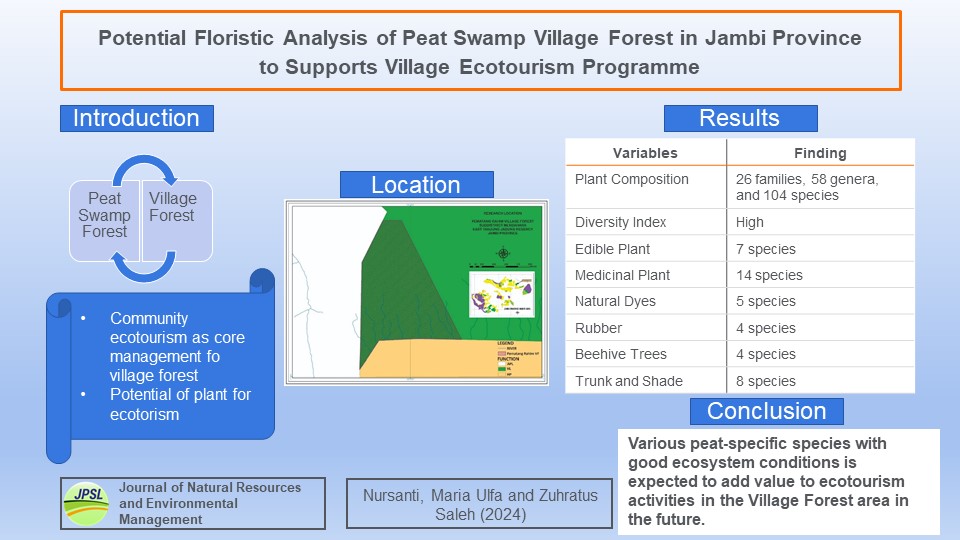Potential Floristic Analysis of Peat Swamp Village Forest in Jambi Province to Supports Village Ecotourism Programme
Abstract
Pematang Rahim Village Forest is one of the social forestry schemes offered by the government. Pematang Rahim Village Forest Management Institute makes ecotourism as the basis for its management. Ecotourism in peat ecosystems in village forests creates biodiversity inside, especially plants, as the basis for planned ecotourism. The purpose of this research is to obtain data and information about the potential flora to support ecotourism-based village forest management. This study was carried out for 8 months from March to October 2021, located in the Village Forest of Pematang Rahim, East Tanjung Jabung Regency, and further analysis was conducted at the Herbarium and Laboratory of Management, Department of Forestry, Faculty of Agriculture, Jambi University. Research results in the field show that peat forests are generally managed as village forests in Pematang rahim in good condition. There are various types of trees and plants in different
life forms. The study found 26 families, 58 genera, and 104 species, with a total of 2,831 individuals consisting of 855 seedlings, 880 saplings, 546 poles, and 550 trees. The diversity index showed a high value (> 3) for each growth stage from seedlings, sapling, pole to trees (3.39; 3.56; 3.65; 3.79). The existence of various peat-specific species with ecosystem conditions that are still maintained is expected to add value to ecotourism activities in the Pematang Rahim Village Forest area in the future.
References
Blackham GV, Webb EL, Corlett RT. 2014. Natural regeneration in a degraded tropical peatland, Central Kalimantan, Indonesia: Implications for forest restoration. Forest Ecology and Management, 324, 8-15. doi: 10.1016/j.foreco.2014.03.041.
Carrugati L, Gatto B, Rastelli E, Martire M L, Coral C, Greco S, Danovaro R. 2018. Impact of mangrove forests degradation on biodiversity and ecosystem functioning. Scientific Reports 8:13298.
Garsetiasih R, Heriyanto NM, Adinugroho WC, Gunawan H, Dharmawan IWS, Sawitri R, Yeny I, Mindawati N, Denny. 2022. Connectivity of vegetation diversity, carbon stock, and peat depth in peatland ecosystems. Global J. Environ. Sci. Manage. 8(3): 369-388, DOI: 10.22034/gjesm.2022.03.06
Habibullah M S, Din BH, Chong CW, Radam A., 2016 Tourism and biodiversity loss: implications for business sustainability. Procedia Economics and Finance 35:166-172.
Hakim L. 2017 Managing biodiversity for a competitive ecotourism industry in tropical developing countries: new opportunities in biological fields. AIP Conference Proceedings 1908(1):030008.
Harrison PA, Berry PM., Simpson G., Haslett J R., Blicharska M, Bucur M, Dunford R, Egoh B, Garcia-Liorente M, Geamana N, Geertsema W, Lommelen E, Meiresonne L, Turkelboom F. 2014. Linkages between biodiversity attributes and ecosystem services: a systematic review. Ecosystem Services 9:191-203.
Indriyanto. 2006. Ekologi hutan. Jakarta: Bumi Aksara.
Malik A, Rahim A, Sideng U, Rasyid A, Jumaddin J.., 2019 Biodiversity assessment of mangrove vegetation for the sustainability of ecotourism in West Sulawesi, Indonesia. AACL Bioflux 12(4):1458-1466.
Mawazin, Subiakto A. 2013. Keanekaragaman dan komposisi jenis permudaan alam hutan rawa gambut bekas tebangan di Riau. Forest Rehabilitation Journal, 1(1), 59-73. doi: 10.9868/ifrj.1.1.59-73.
Mondino E, Beery T. 2018. Ecotourism as a learning tool for sustainable development. The case of Monviso Transboundary Biosphere Reserve, Italy. Journal of Ecotourism 18:1-15.
Nursanti, Wulan C, Junita R. 2018. Potensi Ekowisata di Desa Air Hitam Laut Sebagai Desa Penyangga Taman Nasional Berbak Sembilang. Jurnal Sylva Tropika 2(3): 84-88
Odum EP. 1993. Dasar-dasar Ekologi. Terjemahan Tjahjono Samingan. Edisi. Ketiga. Yogyakarta: Gadjah Mada University Press
Rachmanadi D, Faridah E, Sumardi, Van der Meer P. (2017). Keanekaragaman potensi regenerasi vegetasi pada hutan rawa gambut: Studi kasus di Kawasan Hutan Dengan Tujuan Khusus (KHDTK) Tumbang Nusa, Kalimantan Tengah. Jurnal Ilmu Kehutanan 11(2), 224-238. doi: 10.22146/jik.28286.
Sukenti K, Hakim L, Indriyani S, Purwanto Y, Matthews PJ. 2016. Ethnobotanical study on local cuisine of the Sasak tribe in Lombok Island, Indonesia. Journal of Ethnic Foods 3, 189-200.
Tamin, RP., Ulfa, M., Saleh, Z. 2021. Identifikasi potensi permudaan alam di hutan rawa gambut taman hutan raya orang kayo hitam provinsi jambi pasca kebakaran hutan. Al-Kauniyah: Jurnal Biologi 14(1): 42-51
Tamin RP, Ulfa M, Saleh Z. 2019. Identifikasi potensi pohon induk pada tegakan tinggal Taman Hutan Raya Orang Kayo Hitam pasca kebakaran hutan. Jurnal Ilmiah Ilmu Terapan Universitas Jambi 3(1): 10-17.
Tamin, RP, Ulfa, M, Saleh Z. 2018. Komunitas tumbuhan pada habitat Nepenthes mirabilis di Tahura Sekitar Tanjung pasca kebakaran hutan. Jurnal Ilmiah Ilmu Terapan 2 (1): 25-31.
Ulfa M, Ahyauddin, Wulan C, Rejeki WS. 2022. Pengetahuan masyarakat terhadap Hutan Desa Pematang Rahim Kabupaten Tanjung Jabung Timur Provinsi Jambi. Jurnal Hutan Lestari 10 (1): 178-185. DOI.http://dx.doi.org/10.26418/jhl.v10i1.52345
Wijedasa LS, Vernimmen R, Page SE, Mulyadi D, Bahri S, Randi A, Hooijer A. 2020. Distance to forest, mammal and bird dispersal drive natural regeneration on degraded tropical peatland. Forest Ecology and Management, 461, 117868.
Authors

This work is licensed under a Creative Commons Attribution 4.0 International License.
Authors who publish with this journal agree to the following terms:
- Authors retain copyright and grant the journal right of first publication with the work simultaneously licensed under a Creative Commons Attribution License that allows others to share the work with an acknowledgement of the work's authorship and initial publication in this journal.
- Authors are able to enter into separate, additional contractual arrangements for the non-exclusive distribution of the journal's published version of the work (e.g., post it to an institutional repository or publish it in a book), with an acknowledgement of its initial publication in this journal.
- Authors are permitted and encouraged to post their work online (e.g., in institutional repositories or on their website) prior to and during the submission process, as it can lead to productive exchanges, as well as earlier and greater citation of published work (See The Effect of Open Access).






